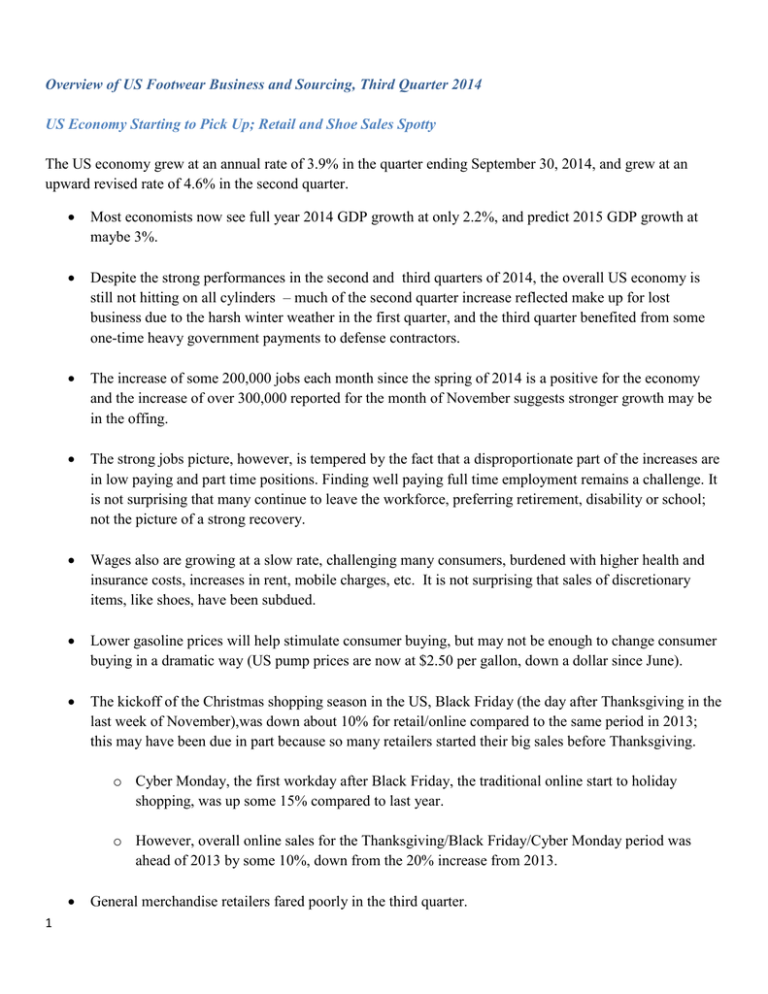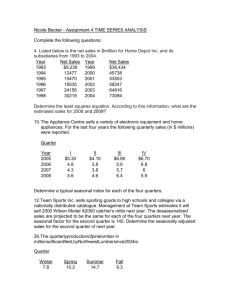
Overview of US Footwear Business and Sourcing, Third Quarter 2014
US Economy Starting to Pick Up; Retail and Shoe Sales Spotty
The US economy grew at an annual rate of 3.9% in the quarter ending September 30, 2014, and grew at an
upward revised rate of 4.6% in the second quarter.
Most economists now see full year 2014 GDP growth at only 2.2%, and predict 2015 GDP growth at
maybe 3%.
Despite the strong performances in the second and third quarters of 2014, the overall US economy is
still not hitting on all cylinders – much of the second quarter increase reflected make up for lost
business due to the harsh winter weather in the first quarter, and the third quarter benefited from some
one-time heavy government payments to defense contractors.
The increase of some 200,000 jobs each month since the spring of 2014 is a positive for the economy
and the increase of over 300,000 reported for the month of November suggests stronger growth may be
in the offing.
The strong jobs picture, however, is tempered by the fact that a disproportionate part of the increases are
in low paying and part time positions. Finding well paying full time employment remains a challenge. It
is not surprising that many continue to leave the workforce, preferring retirement, disability or school;
not the picture of a strong recovery.
Wages also are growing at a slow rate, challenging many consumers, burdened with higher health and
insurance costs, increases in rent, mobile charges, etc. It is not surprising that sales of discretionary
items, like shoes, have been subdued.
Lower gasoline prices will help stimulate consumer buying, but may not be enough to change consumer
buying in a dramatic way (US pump prices are now at $2.50 per gallon, down a dollar since June).
The kickoff of the Christmas shopping season in the US, Black Friday (the day after Thanksgiving in the
last week of November),was down about 10% for retail/online compared to the same period in 2013;
this may have been due in part because so many retailers started their big sales before Thanksgiving.
o Cyber Monday, the first workday after Black Friday, the traditional online start to holiday
shopping, was up some 15% compared to last year.
o However, overall online sales for the Thanksgiving/Black Friday/Cyber Monday period was
ahead of 2013 by some 10%, down from the 20% increase from 2013.
1
General merchandise retailers fared poorly in the third quarter.
o Department store leaders Macy’s, Dillards and Kohl’s reported negative sales figures for their
stores excluding those opened or closed in the last year (so-called ‘same store’ sales).
o Fashion leader Nordstorm’s continued its 2014 streak of strong same store sales, up 3.9%, and
mass market leaders, Wal-Mart and Target both eked out tiny same store increases (the first for
either in many quarters).
Footwear business was spotty during the third quarter.
o Mass market, self-service leaders are still struggling, although the largest, Designer Shoe
Warehouse (DSW), reported same store sales up 2.6%, the first decent positive result in more
than a year, while chief competitor, Famous Footwear was slightly in the red for the quarter.
o Sports shoe retailing continues to be dominated by Footlocker, which recorded an impressive
6.9% ‘same store’ sales result for the quarter. Finish Line also reported a strong 4.5% increase
for the third quarter on a ‘same store’ basis.
o These results reflect the strong worldwide performances of both Nike (up 15%) and Adidas (up
10%).
o The street shoe business was mixed, with Sketchers recording an amazing 31% increase (largely
due to success of its ‘go’ lines of walking, running, etc.), while women’s leader, Brown Shoe and
its Naturalizer brand, reported sales up 18.2% for the quarter. Former standout, Steve Madden,
continues its weak performance sliding to a negative 0.7% for the quarter, while outdoor leader
Wolverine World Wide also slipped with sales down 0.8%.
2
3
4
US Sourcing Update – China, Vietnam and Indo account for 95%
Total US shoe imports for the first there quarters of 2014 were flat in pairs compared to the same period
in 2013 – not a ringing endorsement of confidence in consumer buying in the months ahead.
o The average price jumped up 4.8% in the quarter compared to the same period in 2013 with all
major producers recording price increases.
o China’s market share at 80% in pairs was down slightly from 82% recorded for the same period
last year.
o Vietnam continues its strong growth, increasing its market share, now at 11.2% in pairs, up from
9.4% during the same period in 2013. It seems to be capturing share from Indonesia as well as
from China. (Overall, Vietnam’s US imports are now about 14% of China’s in units.)
5
In addition to its strength in branded sport shoes, Vietnam also has strength in some
plastic low prices production (moved from China) as well as solid leather street shoe
output with some one third of its exports to the US in the leather category on a pair’s
basis.
o Cambodia more than doubled its US imports in the quarter, increasing its market share from 3%
to 6%, although its 10.3 million pair imported into the US in the first three quarters of 2014
represents only 0.7% of China’s US imports during that period.
o Strong growth was also reported for Brazil (mostly in plastic brands like Havaianas, Melissa,
etc.) and for Bangladesh, Portugal, Ethiopia, and Nicaragua, all in leather street shoes.
o As for leather shoes, the US imported some $9.6 billion in the three quarters ending September
30, 2014, up 3.9% from the same period in 2013.
China’s market share on a value basis fell to 58% from 61% compared to the same period
in 2013, while Vietnam increased its share to 12.6% from 10.7% and Italy went from
8.8% to 9.5%. Indonesia fell from 5.3% to 4.8% and Mexico fell from 3.3% to 2.9%.
India also lost ground going from 2.4% to 1.9%.
o The strengthening dollar against footwear exporting countries should help keep prices for US
consumers under control in 2015. The greenback has risen this year against the China yuan
2.6%; Brazil real 9.0%, euro 11.8% and Mexico peso 11.8%, among the big currency movers.
6
7
US Imports of Leather Goods – China Continues to Dominate Shoes, Apparel, Gloves and Bags; Mexico
Finished Leather
8
In addition to dominating the leather shoe, import business as noted above, China is also the largest
supplier of leather garments to the US accounting for some 45% by value of imports in the three quarters
ending September 30, 2014, more than double the next largest supplier’s share, Italy at 18% by value.
India is in third place at 14%.
China is also the dominate source for US imports of leather bags and other accessories with a 62%
market share. India, the second largest supplier, has a 9% share and the third largest supplier, Mexico, as
only a 5% share. China also has a 72% share in gloves.
As to finished leather imports, Mexico has a 66% share with Italy and Brazil distant followers at 9% and
7% respectively. Most of the finished leather is for the auto industry.
U.S. Mid-term Election: Republicans Sweep Congress – What does it mean for business?
Free Trade Agreement of Asia Pacific (FTAAP)
Peter T. Mangione, Global Footwear Partnerships LLC, Washington, DC, December 12, 2014,
ptmangione@gmail.com, Copyright@Global Footwear Partnerships LLC. All rights reserved. No
reproduction without written permission.
9







